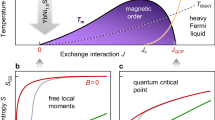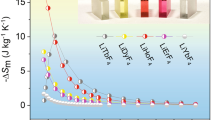Abstract
The magnetocaloric effect is the change in temperature of a material as a result of the alignment of its magnetic spins that occurs on exposure to an external magnetic field. The phenomenon forms the basis for magnetic refrigeration, a concept purported to be more efficient and environmentally friendly than conventional refrigeration systems1,2,3,4,5. In 1997, a ‘giant’ magnetocaloric effect, between 270 K and 300 K, was reported in Gd5Ge2Si2, demonstrating its potential as a near-room-temperature magnetic refrigerant6,7,8. However, large hysteretic losses (which make magnetic refrigeration less efficient) occur in the same temperature range8,9. Here we report the reduction (by more than 90 per cent) of these hysteretic losses by alloying the compound with a small amount of iron. This has the additional benefit of shifting the magnetic entropy change peak (a measure of the refrigerator's optimal operating temperature) from 275 K to 305 K, and broadening its width. Although the addition of iron does not significantly affect the refrigerant capacity of the material, a greater net capacity is obtained for the iron-containing alloy when the hysteresis losses are accounted for. The iron-containing alloy is thus a much-improved magnetic refrigerant for near-room-temperature applications.
This is a preview of subscription content, access via your institution
Access options
Subscribe to this journal
Receive 51 print issues and online access
$199.00 per year
only $3.90 per issue
Buy this article
- Purchase on Springer Link
- Instant access to full article PDF
Prices may be subject to local taxes which are calculated during checkout




Similar content being viewed by others
References
Glanz, J. Making a bigger chill with magnets. Science 279, 2045 (1998)
Tegus, O., Bruck, E., Buschow, K. H. J. & de Boer, F. R. Transition-metal-based refrigerants for room-temperature applications. Nature 415, 150–152 (2002)
Tegus, O. et al. Magnetic-phase transitions and magnetocaloric effects. Physica B 319, 174–192 (2002)
McMichael, R. D., Shull, R. D., Swartzendruber, L. J., Bennett, L. H. & Watson, R. E. Magnetocaloric effect in superparamagnets. J. Magn. Magn. Mater 111, 29–33 (1992)
Fujita, A., Fujieda, S., Hasegawa, Y. & Fukamichi, K. Itinerant-electron metamagnetic transition and large magnetocaloric effects. Phys. Rev. B 67, 104416 (2003)
Pecharsky, V. K. & Gschneidner, K. A. Jr The giant magnetocaloric effect in Gd5(Si2Ge2). Phys. Rev. Lett. 78, 4494–4497 (1997)
Percharsky, A. O., Gschneidner, K. A. Jr & Pecharsky, V. K. The giant magnetocaloric effect of optimally prepared G5Ge2Si2 . J. Appl. Phys. 93, 4722–4728 (2003)
Levin, E. M., Pecharsky, V. K. & Gschneidner, K. A. Jr Unusual magnetic behavior in G5(Ge1.5Si2.5) and G5Ge2Si2 . Phys. Rev. B 62, R14625–R14628 (2000)
Giguere, A. et al. Direct measurements of the ‘giant’ adiabatic temperature change in G5Ge2Si2 . Phys. Rev. Lett. 83, 2262–2265 (1999)
Choe, W. et al. Making and breaking covalent bonds across the magnetic transition in the giant magnetocaloric material Gd5(Ge2Si2). Phys. Rev. Lett. 84, 4617–4620 (2000)
Morellon, L., Algarabel, P. A., Ibarra, M. R., Blasco, J. & Garcia-Landa, B. Magnetic-field-induced structural transition in Gd5(Si1.8Ge2.2). Phys. Rev. B 58, R14721–R14724 (1998)
Meyers, J., Chumbley, S., Choe, W. & Miller, G. J. Microstructural analysis of twinned β-G5Ge2Si2 . Phys. Rev. B 66, 012106 (2002)
Pecharsky, V. K. & Gschneidner, K. A. Jr Phase relationship and crystallography in pseudobinary system Gd5Si4-Gd5Ge4 . J. Alloys Compd. 260, 98–106 (1997)
Gschneidner, K. A. Jr, Pecharsky, V. K., Pecharsky, A. O. & Zimm, C. B. Recent development in magnetic refrigeration. Mater. Sci. Forum 315–317, 69–76 (1999)
Wood, M. E. & Potter, W. H. General analysis of magnetic refrigeration and its optimization using a new concept: maximization of refrigerant capacity. Cryogenics 25, 667–683 (1985)
Shull, R. D., Swartzendruber, L. J. & Bennett, L. H. in Proc. Sixth Int. Cryocoolers Conf. (eds Green, G. & Knox, M.) 231 (Publication no. DTRC-91/002, David Taylor Research Center, Annapolis, Maryland, 1991)
McMichael, R. D., Ritter, J. J. & Shull, R. D. Enhanced magnetocaloric effect in Gd3Ga5-xFexO12 . J. Appl. Phys. 73, 6946–6948 (1993)
Tishin, A. M. Magnetic refrigeration in the low-temperature range. J. Appl. Phys. 68, 6480–6484 (1990)
von Ranke, P. J. et al. Anomalous magnetocaloric effect in YbAs associated with the giant quadrupolar interaction. Phys. Rev. B 63, 24422 (2001)
Acknowledgements
This work was partially supported by the NASA-Goddard Space Flight Center. We thank R. Waterstrat and R. Drew for technical assistance, and M. Lufaso and R. D. McMichael for helpful discussions.
Author information
Authors and Affiliations
Corresponding author
Ethics declarations
Competing interests
The authors declare that they have no competing financial interests.
Rights and permissions
About this article
Cite this article
Provenzano, V., Shapiro, A. & Shull, R. Reduction of hysteresis losses in the magnetic refrigerant Gd5Ge2Si2 by the addition of iron. Nature 429, 853–857 (2004). https://doi.org/10.1038/nature02657
Received:
Accepted:
Issue Date:
DOI: https://doi.org/10.1038/nature02657
This article is cited by
-
Phase transition regulation and caloric effect
Frontiers in Energy (2023)
-
A lanthanide cluster formed by fixing atmospheric CO2 to carbonate: a molecular magnetic refrigerant and photoluminescent material
Journal of Chemical Sciences (2023)
-
Materials, physics and systems for multicaloric cooling
Nature Reviews Materials (2022)
-
Magnetic refrigeration material operating at a full temperature range required for hydrogen liquefaction
Nature Communications (2022)
-
Magnetocaloric Effect, Magnetic Interactions and Phase Transition in La1.3Fe11.6-xSi1.4Gax Alloys
Journal of Superconductivity and Novel Magnetism (2022)
Comments
By submitting a comment you agree to abide by our Terms and Community Guidelines. If you find something abusive or that does not comply with our terms or guidelines please flag it as inappropriate.



